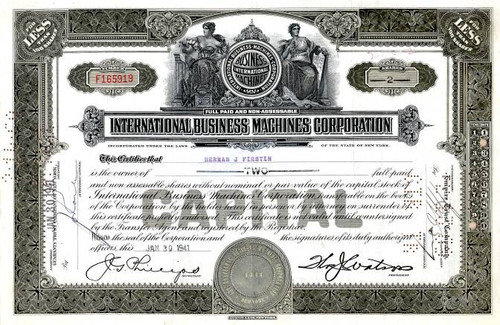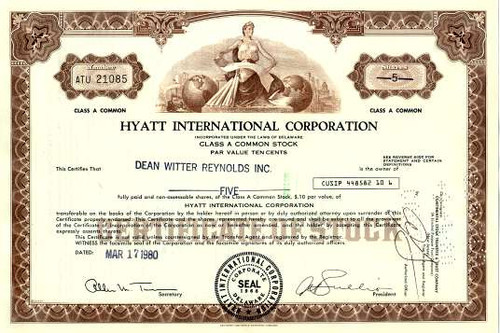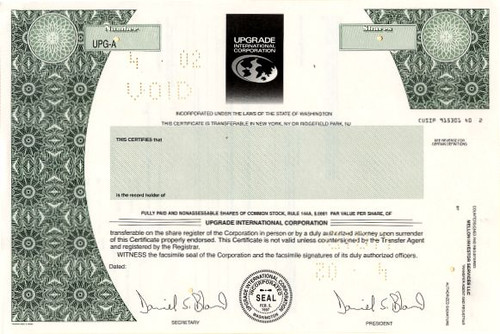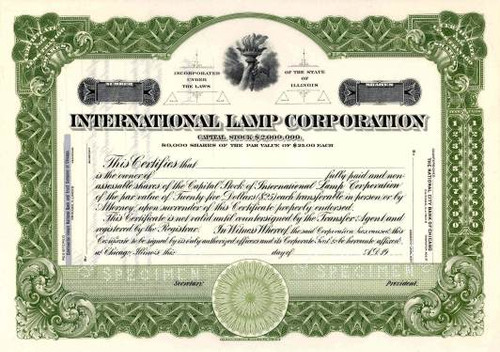Beautifully engraved Blue Certificate from the famous International Business Machines Corporation (IBM) issued no later than 1985. This historic document has an ornate block border with a vignette Mercury flying over the globe. This item has the printed signature of the company's officers and is over 25 years old. 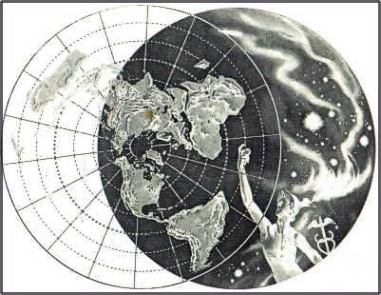
Certificate Vignette IBM was incorporated in the state of New York on June 15, 1911 as the Computing-Tabulating-Recording Company. But its origins can be traced back to 1890, during the height of the Industrial Revolution, when the United States was experiencing waves of immigration. The U.S. Census Bureau knew its traditional methods of counting would not be adequate for measuring the population, so it sponsored a contest to find a more efficient means of tabulating census data. The winner was Herman Hollerith, a German immigrant and Census Bureau statistician, whose Punch Card Tabulating Machine used an electric current to sense holes in punch cards and keep a running total of data. Capitalizing on his success, Hollerith formed the Tabulating Machine Co. in 1896. In 1911, Charles R. Flint, a noted trust organizer, engineered the merger of Hollerith's company with two others, Computing Scale Co. of America and International Time Recording Co. The combined Computing-Tabulating-Recording Co., or C-T-R, manufactured and sold machinery ranging from commercial scales and industrial time recorders to meat and cheese slicers and, of course, tabulators and punch cards. Based in New York City, the company had 1,300 employees and offices and plants in Endicott and Binghamton, N.Y.; Dayton, Ohio; Detroit, Mich.; Washington, D.C., and Toronto, Canada. When the diversified businesses of C-T-R proved difficult to manage, Flint turned for help to the former No. 2 executive at the National Cash Register Co., Thomas J. Watson. In 1914, Watson, age 40, joined the company as general manager. The son of Scottish immigrants, Watson had been a top salesman at NCR, but left after clashing with its autocratic leader, John Henry Patterson. However, Watson did adopt some of Patterson's more effective business tactics: generous sales incentives, an insistence on well-groomed, dark-suited salesmen and an evangelical fervor for instilling company pride and loyalty in every worker. Watson boosted company spirit with employee sports teams, family outings and a company band. He preached a positive outlook, and his favorite slogan, "THINK," became a mantra for C-T-R's employees. Watson also stressed the importance of the customer, a lasting IBM tenet. He understood that the success of the client translated into the success of his company, a belief that, years later, manifested itself in the popular adage, "Nobody was ever fired for buying from IBM." Within 11 months of joining C-T-R, Watson became its president. The company focused on providing large-scale, custom-built tabulating solutions for businesses, leaving the market for small office products to others. During Watson's first four years, revenues doubled to $2 million. He also expanded the company's operations to Europe, South America, Asia and Australia. In 1924, to reflect C-T-R's growing worldwide presence, its name was changed to International Business Machines Corp., or IBM. During the Great Depression of the 1930s, IBM managed to grow while the rest of the U.S. economy floundered. Watson took care of his employees. IBM was among the first corporations to provide group life insurance (1934), survivor benefits (1935) and paid vacations (1936). While most businesses had shut down, Watson kept his workers busy producing new machines even while demand was slack. Thanks to the resulting large inventory of equipment, IBM was ready when the Social Security Act of 1935 brought the company a landmark government contract to maintain employment records for 26 million people. It was called "the biggest accounting operation of all time," and it went so well that orders from other U.S. government departments quickly followed. The Social Security deal was secured even while IBM was at odds with another branch of the federal government. The Justice Department filed an antitrust case against IBM and Remington-Rand in 1932, alleging that the two companies, which controlled virtually the entire market for punch card machines, were illegally requiring customers to buy their punch cards. The case went to the Supreme Court, which ruled in favor of the Justice Department in 1936. In subsequent years, IBM's size and success would inspire numerous antitrust actions. A 1952 suit by the Justice Department, settled four years later, forced IBM to sell its tabulating machines -- at the time, IBM offered them only through leases -- in order to establish a competing, used-machine market. Another federal antitrust suit dragged on for thirteen years until the Justice Department concluded it was "without merit" and dropped it in 1982. IBM's competitors filed 20 antitrust actions during the 1970s. None succeeded. When World War II began, all IBM facilities were placed at the disposal of the U.S. government. IBM's product line expanded to include bombsights, rifles and engine parts -- in all, more than three dozen major ordnance items. Watson set a nominal one-percent profit on those products and used the money to establish a fund for widows and orphans of IBM war casualties. The war years also marked IBM's first steps toward computing. The Automatic Sequence Controlled Calculator, also called the Mark I, was completed in 1944 after six years of development with Harvard University. It was the first machine that could execute long computations automatically. Over 50 feet long, 8 feet high, and weighing almost 5 tons, the Mark I took less than a second to solve an addition problem, but about six seconds for multiplication and twice as long for division -- far slower than any pocket calculator today. In 1952, the company introduced the IBM 701, its first large computer based on the vacuum tube. The tubes were quicker, smaller, and more easily replaceable than the electromechanical switches in the Mark I. The 701 executed 17,000 instructions per second and was used primarily for government and research work. But vacuum tubes rapidly moved computers into business applications such as billing, payroll and inventory control. By 1959, transistors were replacing vacuum tubes. The IBM 7090, one of the first fully transistorized mainframes, could perform 229,000 calculations per second. The Air Force used the 7090 to run its Ballistic Missile Early Warning System. In 1964, American Airlines' SABRE reservations system used two 7090 mainframes to link sales desks in 65 cities. IBM led data processing in a new direction with the 1957 delivery of the IBM 305 Random Access Method of Accounting and Control (RAMAC), the first computer disk storage system. Such machines became the industry's basic storage medium for transaction processing. In less than a second, the RAMAC's "random access" arm could retrieve data stored on any of 50 spinning disks. At an IBM exhibit at the 1958 World's Fair in Brussels, the RAMAC answered world history questions in ten languages. Also in 1957, IBM introduced FORTRAN (FORmula TRANslation), a computer language based on algebra, grammar and syntax rules. It became the most widely used computer language for technical work. A new generation of IBM leadership oversaw this period of rapid technology change. After nearly four decades as IBM's chief executive, Thomas Watson passed the title of president on to his son, Thomas Watson Jr., in 1952. (Another family member, Tom Jr.'s younger brother Arthur K. Watson, built the World Trade Corporation -- IBM's foreign operations -- into such a dominating force that it had installed 90 percent of the computers in Europe by the 1960s.) Born the year his father was hired by C-T-R in 1914, Tom Watson Jr. had been heir apparent since joining IBM in 1937 as a salesman. After a five-year interruption, during which he served as a pilot in the U.S. Army Air Corps, Watson Jr. rejoined the company in 1946, and was named a vice president six months later. He became chief executive officer just six weeks before his father's death on June 19, 1956 at age 82. Just as his father saw the company's future in tabulators rather than scales and meat slicers, Tom Watson Jr. foresaw the role computers would play in business, and he pushed IBM to meet the challenge. He led the company's transformation from a medium-sized maker of tabulating equipment and typewriters to an industrial giant. During his stewardship, revenue grew from $900 million to $8 billion, and the number of employees rose from 72,500 to 270,000. On April 7, 1964, IBM introduced the System/360, the first large "family" of computers to use interchangeable software and peripheral equipment. Rather than purchase a new system when the need and budget grew, customers now could simply upgrade parts of their hardware. It was a bold departure from the monolithic, one-size-fits-all mainframe. Fortune magazine dubbed it "IBM's $5 billion gamble." System/360 offered a choice of five processors and 19 combinations of power, speed and memory. A user could operate the same magnetic tape and disk products as another user with a processor 100 times more powerful. System/360 also offered dramatic performance gains, thanks to Solid Logic Technology (SLT) -- half-inch ceramic modules containing circuitry far denser, faster and more reliable than earlier transistors. Under Tom Watson Jr., there also were innovations in marketing. In 1969, IBM changed the way it sold technology. Rather than offer hardware, services and software exclusively in packages, marketers "unbundled" the components and offered them for sale individually. Unbundling gave birth to the multibillion-dollar software and services industries. Today, IBM is the world leader in both industries. The 1970s saw the end of more than a half-century of Watson family leadership. Tom Watson Jr. stepped down as CEO in 1971. After an interim period of leadership by T. Vincent Learson, Frank T. Cary took over the company in 1973. Watson served as U.S. ambassador to the Soviet Union from 1979 to 1981 and remained a member of IBM's board of directors until 1984. He died in 1993 at the age of 79. During Cary's tenure, the computer industry expanded and wove its way into everyday life. The floppy disk, introduced in 1971, became the standard for storing personal computer data. When people shopped for groceries, IBM's supermarket checkout station, introduced in 1973, used glass prisms, lenses and a laser to read product prices. Also in 1973, bank customers began making withdrawals, transfers and other account inquiries via the IBM 3614 Consumer Transaction Facility, an early form of today's Automatic Teller Machines. John R. Opel's appointment as CEO in 1981 coincided with the beginning of a new era of computing. Thanks to the birth of the IBM Personal Computer, or PC, the IBM brand began to enter homes, small businesses and schools. Though not a spectacular machine by technological standards, the IBM PC brought together all of the most desirable features of a computer into one small machine. It offered 16 kilobytes of memory (expandable to 256 kilobytes), one or two floppy disk drives and an optional color monitor. When designing the PC, IBM for the first time contracted the production of its components to outside companies. The processor chip came from Intel, and the operating system, called DOS (Disk Operating System), came from a 32-person company called Microsoft. John F. Akers became CEO in 1985 and focused on streamlining operations and redeploying resources. IBM's typewriter, keyboard, and printer business -- the division that created the popular "Selectric" typewriter with its floating "golf ball" type element in the 1960s -- was sold to the investment firm of Clayton, Dubilier & Rice Inc. and became an independent company, Lexmark Inc. During Akers' tenure, IBM's significant investment in research produced four Nobel Prize winners in physics, achieved breakthroughs in mathematics, memory storage and telecommunications, and made great strides in expanding computing capabilities. The IBM token-ring local area network, introduced in 1985, permitted personal computer users to exchange information and share printers and files within a building or complex. With the further development of the computer, IBM laid a foundation for network computing and numerous other applications. Despite these advances, this was a period when IBM struggled. During the 1980s and early 1990s, IBM was thrown into turmoil by back-to-back revolutions. The PC revolution placed computers directly in the hands of millions of people. And then, the client/server revolution sought to link all of those PCs (the "clients") with larger computers that labored in the background (the "servers" that served data and applications to client machines). Both revolutions transformed the way customers viewed, used and bought technology. And both fundamentally rocked IBM. Businesses' purchasing decisions were put in the hands of individuals and departments -- not the places where IBM had long-standing customer relationships. Piece-part technologies took precedence over integrated solutions. The focus was on the desktop and personal productivity, not on business applications across the enterprise. By 1993, the company's annual net losses reached a record $8 billion. Cost management and streamlining became a chief concern. And IBM considered splitting its divisions into separate independent businesses. Louis V. Gerstner Jr. arrived as IBM's chairman and CEO on April 1, 1993. For the first time in the company's history IBM had found a leader from outside its ranks. Gerstner had been chairman and CEO of RJR Nabisco for four years, and had previously spent 11 years as a top executive at American Express. Gerstner brought with him a customer-oriented sensibility and the strategic-thinking expertise that he had honed through years as a management consultant at McKinsey & Co. Soon after he arrived, he had to take dramatic action to stabilize the company. These steps included rebuilding IBM's product line, continuing to shrink the workforce and making significant cost reductions. Despite mounting pressure to split IBM into separate, independent companies, Gerstner decided to keep the company together. He recognized that one of IBM's enduring strengths was its ability to provide integrated solutions for customers -- someone to represent more than piece parts or components. Splitting the company would have destroyed a unique IBM advantage. With the rise of the Internet and network computing the company experienced another dramatic shift in the industry. But this time IBM was better prepared. All the hard work IBM had done to catch up in the client/server field served the company well in the network computing era. Once again, customers were focused on integrated business solutions -- a key IBM strength that combined the company's expertise in solutions, services, products and technologies. In the fall of 1995, delivering the keynote address at the COMDEX computer industry trade show in Las Vegas, Gerstner articulated IBM's new vision -- that network computing would drive the next phase of industry growth and would be the company's overarching strategy. That year, IBM acquired Lotus Development Corp., and the next year acquired Tivoli Systems Inc. Services became the fastest growing segment of the company, with growth at more than 20 percent per year. From 1993 to 1996, the market value of the company increased by more than $50 billion. In May 1997, IBM dramatically demonstrated computing's potential with Deep Blue, a 32-node IBM RS/6000 SP computer programmed to play chess on a world class level. In a six-game match in New York, Deep Blue defeated World Chess Champion Garry Kasparov. It was the first time a computer had beaten a top-ranked chess player in tournament play, and it ignited a public debate on how close computers could come to approximating human intelligence. The scientists behind Deep Blue, however, preferred to stress more practical concerns. Deep Blue's calculating power -- it could assess 200 million chess moves per second -- had a wide range of applications in fields calling for the systematic exploration of a vast number of variables, among them forecasting weather, modeling financial data and developing new drug therapies.

Certificate Vignette





